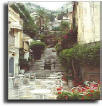|
Taormina
is 249 km. distant from Agrigento, 183 km. from Caltanissetta, 57 km. from
Catania, 154 km. from Enna, 45 km. from Messina, which province it belongs
to, 282 km. from Palermo, 161 km. from Ragusa, 115 km. from Siracusa, 381
km. from Trapani.
The
municipality has 10.465 inhabitants and an area of 1.316 hectares for a
population density of 795 inhabitants per square kilometre. It rises on a
hilly area and is 206 metres above sea-level.
Taormina is famous for its tourism which makes of it one of the chief town of Sicilian tourism. The pretty town bases its production upon vegetables and fruit and also upon fresh fish. Local handicraft is based upon wood and iron works and handmade embroideries. Taormina is part of towns of Vitùlia, the calves' land, and its name derives both from Greek Tauromenion and from Latin Tauromenium and both has the same meaning "Bull". Many civilizations followed one upon the other as from the VIII century B.C. in Taormina's territory. Originary Sicilians' town, in 392 it was conquered by Dionysius I of Siracusa, in 358 by Anomarco, historian Timeo's father and in 345 by Corinthian general Timoleonte. It was later possession of Agatocle and Ierone II of Siracusa. In 212 it had a great development and passed with all the Sicily into Romans' hand. Normans were in possession of it in1079 and made of it a prosperous town for all the medieval period. In the XVII century most of its territory was for sale to Spanishes and the revolt against them in 1674 did nothing but cause further impoverishments. It was left out of every sort of trade and so it opened to industry and got excellent results.
Militar walls of Mount Tauro are of medieval period. They push on as far
as Castle made built at first by Arabs and finished by Normans towards the
end of ‘300. The most important monuments are the Covaja Palace, old seat
of Sicilian Parliament; Palace of Dukes of St. Stefano; the XVth-century
Ciampoli Palace; the Basilica of St. Nicolò with its inside a painting on
board made by A. Giuffrè (1463-1510); the Torre dell‘Orologio (Tower of
the Clock) with Porta di Mezzo through which it is possible to enter in
the village; ex Convent of St. Domenico with annexed the Church which
keeps some original elements such as the Cloister and the bell-tower; the
Old Abbey or Badiazza, a Norman battlement tower. Taormina, considered the pearl of Sicilian tourism, organizes in July and August the famous show of cinema, music and theatre, the "Taormina Arte" which earns great echo all over Sicily. |

